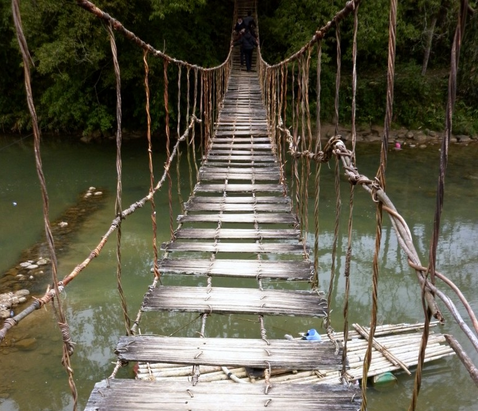 NEWS
NEWS
 NEWS
NEWS
 NEWS
NEWS
![]() You may not have seen last night’s news about the collapsed freeway bridge in Washington State that sent cars tumbling into the icy waters of the River Skagit, 55 miles north of Seattle. Thankfully rescuers say that nobody was seriously hurt – hence the story wasn’t headline news – but the incident serves to highlight one of the many benefits that we can look forward to in the near future as the Internet of Things rapidly evolves.
You may not have seen last night’s news about the collapsed freeway bridge in Washington State that sent cars tumbling into the icy waters of the River Skagit, 55 miles north of Seattle. Thankfully rescuers say that nobody was seriously hurt – hence the story wasn’t headline news – but the incident serves to highlight one of the many benefits that we can look forward to in the near future as the Internet of Things rapidly evolves.
Bridges, like all buildings, need to undergo constant monitoring in order to avoid sudden and disastrous collapses like the one we saw today. Unfortunately, as today’s incident underlines, we’re not actually very good at doing so – the sheer number of bridges in the US (something like 600,000 at the last count) means that constantly checking them all requires a huge amount of time, labor, money and expertise.
Aside from the cost of visually inspecting bridges, these tests just aren’t that reliable. Engineers, as qualified as they may be, will often fail to spot structural problems in time to prevent catastrophes. The collapse of the I-35W Mississippi River bridge in Minnesota that killed 13 people is a case in point – the National Transportation Safety Board later found that engineers had missed faults with 16 of the gusset plates connecting the trusses, which were the reason for the collapse.
The Minnesota tragedy (and most probably, the Washington state bridge collapse) could have been prevented had the bridge been equipped with smart senors that allow engineers to constantly monitor its structural integrity.
Smart bridges, or intelligent bridges, as they’re also known, already exist in many parts of the world. One of the outstanding examples is the six lane, 2.9km long Rio-Antirrio Bridge in Greece, which has been equipped with a network of 100 sensors that constantly monitor its structural condition, feeding this data to engineers who are able to deal with any problems as soon as they come up. These sensors were to prove their value soon after the bridge opened in 2004, when they showed that the cables holding the bridge where displaying abnormal vibrations. This early warning gave engineers the chance to install additional weight to dampen the cables and prevent a collapse.
Intelligent bridges are only possible thanks to the evolution of The Internet of Things, a concept of the future that envisions that one day, every kind of electronic device, including bridges, will be hooked up to the internet. The sensor technology being used is actually nothing new – but it’s only thanks to the widespread use of wide area networking, or WAN, that these sensors can now be linked to a centralized data collection point.
From this collection point, the data can then be sent over the net to a database that automatically gives a warning when stress levels detected in the bridge go beyond acceptable standards. Maintenance teams can immediately inform the police to close the bridge if necessary, before rushing out to carry out repairs or modifications. Another benefit is that over the long run, as more and more data is collected, engineers may be able to predict events and carry out preventative maintenance before any warnings are given.
![]() For now, the concept of Smart bridges is still in its infancy. The Internet of Things has made it possible to communicate with bridges, but the sensors themselves still need improvement. Current sensor technology (see image) remains somewhat basic – its still unable to pinpoint what’s happening in specific parts of a structure, and so when something appears wrong with the data engineers still need to spend a long time investigating where the problem is.
For now, the concept of Smart bridges is still in its infancy. The Internet of Things has made it possible to communicate with bridges, but the sensors themselves still need improvement. Current sensor technology (see image) remains somewhat basic – its still unable to pinpoint what’s happening in specific parts of a structure, and so when something appears wrong with the data engineers still need to spend a long time investigating where the problem is.
To combat this, researchers are working on more advanced sensors that’ll be able to pinpoint structural problems to within just a few millimetres. One of the most promising designs, currently being developed by the University of Michigan, is an intelligent ‘sensory skin’ based on carbon nanotubes – basically a kind of intelligent membrane that can be painted onto the surface of the concrete. When stimulated by an electric current, this intelligent skin will be able to identify where cracks or located and even spot damage inside the structure that can’t be seen with the naked eye.
Aside from making our bridges safer, The Internet of Things provides other benefits too. The data collected from intelligent bridges will help engineers to establish baselines for the future, ensuring that tomorrow’s bridges are built to much higher safety standards than ever before.
Support our mission to keep content open and free by engaging with theCUBE community. Join theCUBE’s Alumni Trust Network, where technology leaders connect, share intelligence and create opportunities.
Founded by tech visionaries John Furrier and Dave Vellante, SiliconANGLE Media has built a dynamic ecosystem of industry-leading digital media brands that reach 15+ million elite tech professionals. Our new proprietary theCUBE AI Video Cloud is breaking ground in audience interaction, leveraging theCUBEai.com neural network to help technology companies make data-driven decisions and stay at the forefront of industry conversations.